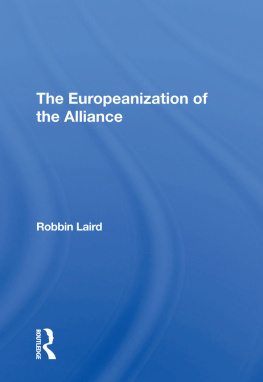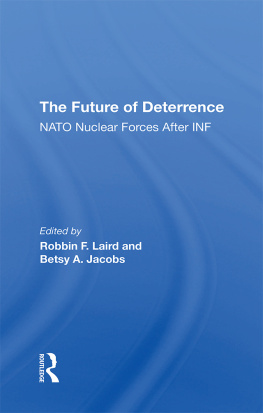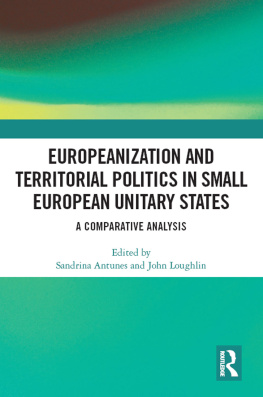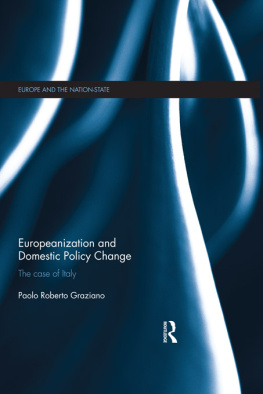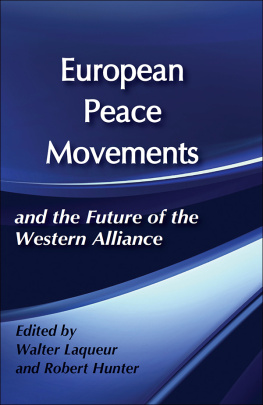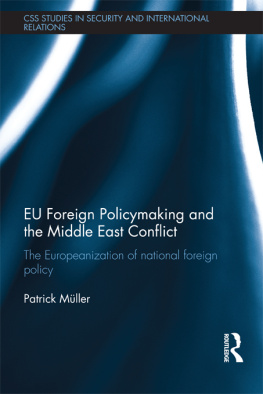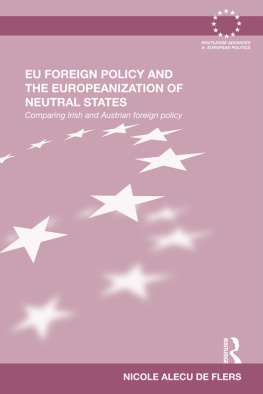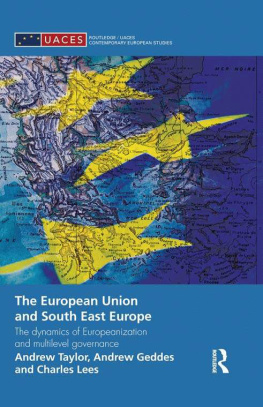The Europeanization of the Alliance
The Europeanization of the Alliance
Robbin Laird
First published 1991 by Westview Press, Inc.
Published 2019 by Routledge
52 Vanderbilt Avenue, New York, NY 10017
2 Park Square, Milton Park, Abingdon, Oxon OX14 4RN
Routledge is an imprint of the Taylor & Francis Group, an informa business
Copyright 1991 Taylor & Francis
All rights reserved. No part of this book may be reprinted or reproduced or utilised in any form or by any electronic, mechanical, or other means, now known or hereafter invented, including photocopying and recording, or in any information storage or retrieval system, without permission in writing from the publishers.
Notice:
Product or corporate names may be trademarks or registered trademarks, and are used only for identification and explanation without intent to infringe.
Library of Congress Cataloging-in-Publication Data
Laird, Robbin F. (Robbin Frederick), 1946
The Europeanization of the Alliance / Robbin Laird.
p. cm.
Includes index.
ISBN 0-8133-8274-2
1. North Atlantic Treaty Organization. 2. EuropeNational security. I. Title.
UA646.3.L3 1991
355'.03304dc20
91-2807
CIP
ISBN 13: 978-0-367-29191-4 (hbk)
To Nicole and Christian Delaporte in recognition of their hospitality and kindness
This book is the result of several years of interviewing senior officials and specialists in Western Europe. The author would like to thank these officials for their time and insights without which the current work could not have been written.
A number of individuals have contributed directly to the writing of this book and I would like to recognize their contribution. The chapter on the Western European Union was assisted by the thoughts and inputs of Michael Clarke, deputy director of the new Centre for Defence Studies affiliated with Kings College, London. The chapter on the European security triangle was a product developed in part with the assistance of Phil Williams, formerly of Chatham House and now of the University of Pittsburgh. For their special contribution during the drafting of the manuscript, I would like to dedicate this book to Nicole and Christian Delaporte.
Finally, I would like to thank the Thyssen Foundation for a grant to support the writing of this manuscript. I would also like to thank Gerry Livingston and the staff of the American Institute for Contemporary German Studies for working with me in the process of developing the project and ultimately delivering it for publication. I would especially wish to thank Susan Clark for her reworking of my manuscript, in addition, Theo Gemelas was very instrumental in seeing the manuscript through to completion in a timely manner.
Robbin Laird
This book identifies and assesses a number of key dimensions of change in the Western Alliance in the 1980s, through the end of 1990. It is obvious that after the revolution of 1989 in Europe, the Alliance is in the throes of major change. The old East-West divide is being overcome by revolutions within Eastern Europe and the dynamics of change in the Soviet Union. With change of such dimension, it is not surprising that the Western system of collective defense is changing as well.
But one of the main points of this book is that change within the Alliance has been particularly dramatic in the 1980s, even before the revolution of 1989. Throughout the 1980s, a range of West European politicians emphasized the importance of rebuilding the Alliance. Their theme was the importance of Europeanizing the Alliance, which clearly signified different things to different politicians. By this, some European politicians meant building a European pillar, so that the role of Europe would be enhanced within the Alliance. For others, the task was to transform the Alliance, whereby the Europeans would become significantly more responsible for their defense while the Americans would play a subordinate role. For some on the left of the political specturm, Europeanization meant building a European security system which marginalized the superpowers.
The reactivation of the Western European Union (WEU), the resuscitation of the Elyse Treaty clause on security consultation in the Franco German treaty of 1963, the development of an Anglo-French security dialogue at the Ministry of Defense (MOD) level, and the construction of a Mediterranean security triangle among France, Italy and Spain, are among the most prominent and central elements in the Europeanization effort. The Europeans were seeking through concrete steps at the multilateral and bilateral level to expand their security dialogue. There was no simple path to changing the transatlantic alliance, but the Europeans were exploring ways to Europeanize the alliance.
These efforts went relatively unnoticed on this side of the ocean. Americans focused primarily upon the traditional Alliance framework. The revolution of 1989 accentuated the elements of dialogue among the Europeans about the future of European security arrangements. For example, the CSCE process (a process never considered central to the U.S.) quickly became a focal point for the intra-European consultation process. Searching for ways to construct a new Europe across the traditional European divide now became a key element of the intra-European process. Also, the question of how to deal with the emergence of a new unifying Germany became critical to intra-European consultation.
The Alliance formalized the need for change in the July 1990 NATO declaration. The language of the NATO communique underscores the challenges confronting NATO. "The North Atlantic Alliance has been the most successful defensive alliance in history. As our Alliance enters its fifth decade and looks ahead to a new century, it must continue to provide for the common defense. This Alliance has done much to bring about the new Europe. No one, however, can be certain of the future. We need to keep standing together, to extend the long peace we have enjoyed these past four decades. Yet our Alliance must be even more an agent of change."
This book is about the transformation of the Western Alliance and the future of Wsstern collective defense. The Western collective defense effort is broader than the NATO organizational effort. It includes bilateral and multilateral relations outside of the formal NATO machinery. It includes various aspects of consultation within that framework as well. The process of change facing the West requires us to take the historically developed experience of collective defense and to adapt it to new times and conditions. This book provides assessments of the efforts to do so to date and the challenges confronting the West in the near- to mid-term future in further developing the Western collective defense system.
Some have argued that the sole purpose of the Western Alliance has been to counter the direct Soviet military challenge. They believe that absent as forceful a Soviet threat as we have confronted in the past, we
Such a view is a narrow one at best. Without doubt the main thrust of NATO has been to provide for the common defense against a common adversary. But NATO is not the sole means for ensuring collective defense in the West- The key states of the Alliance have developed defense structures to deal with a range of threats to their existence and interests. The crisis in the Persian Gulf certainly underscores the importance to the West of having individual defense structures. It is also clear that these key countries have found it useful to cooperate on a bilateral and multilateral basis. This habit of cooperation is the core of what I believe to be the historic achievement of the Western Alliance. This achievement can be carried forward by key Western countries only if they alter the framework of their interaction away from traditional NATO patterns of cooperation. One of the key arguments of this book is that they had already done so prior to the revolution of 1989, and that the events of 1989 and 1990 will only propel them further in adapting Alliance structures. From this standpoint, the Alliance is a mix of institutions - NATO, bilateral, multilateral non-NATO, and national defense efforts defined with collective purposes in mind.


